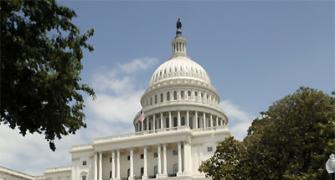.jpg?w=670&h=900) Interest rates in India are set to rise further.
Interest rates in India are set to rise further.
The spread between 10-year government bond yields in the US and India has fallen to a two-year low, while the gap between the rates of retail inflation in the two countries is at a three-year high.
Over the past 12 months, the yield on 10-year US treasury bonds has risen 120 basis points, to 2.9 per cent, even as the rate of retail inflation in that country, at around 1.7 per cent, has remained unchanged.
Else, more capital outflow and pressure on rupee likely But the situation in India is diametrically opposite.
Bond yields have hardly moved up over the past year, while the retail inflation rate has remained in the double-digit territory.
This has led the real interest rate (nominal interest rate adjusted for inflation) to turning negative in India, while in the US it remains positive and is rising (see chart).
Experts say this has made India unattractive for global investors, leading to capital outflow and exerting downward pressure on the rupee.
“When an investor can earn two per cent risk-free yield in the US, why will he invest in a country with negative real interest rates?” asks CARE Ratings’ Chief Economist Madan Sabnavis. For this anomaly to be corrected in India, either the nominal interest rate has to rise or inflation has to come down.
This might explain the recent surge in yields (or interest rate) on government bonds.
Early last week, yield on the 10-year bond briefly touched 9.47 per cent before settling at a sub-8.5 per cent level as the Reserve Bank of India intervened by allowing banks to defer mark-to-market losses (writing down values on current values) on bond holdings.
There is a negative correlation between bond prices and yields. High yields or interest rates lead to decline in bond prices, and vice versa.
This has also turned the screws on foreign institutional investors' investments in equities.
“The rupee’s depreciation reduces potential returns for FIIs from the Indian equity market, giving them another reason to reduce their exposure to India,” says Devang Mehta, vice-president and head (equity sales),
Historically, the bond yields in India have tracked the inflation rate. From 2004 to 2008, bond yields rose in line with the rise in the retail inflation rate (as measured by the Consumer Price Index for Industrial Workers).
The nexus broke in the post-Lehman-crisis period, as major central banks flooded global markets with easy liquidity to avert an economic recession.
The impact was clearly visible in India in the bond yields, which fell sharply in the last quarter of 2008 -- bottoming out at 5.3 per cent in the last week of December 2008, from a high of 9.4 per cent in late July.
The retail inflation rate, however, continued to accelerate and peaked at 16.22 per cent in January 2010, nearly triple its December-2007 level.
This pushed interest rates into the negative territory for the first time since 2003.
In comparison, the economic boom from 2003 to 2007 was accompanied by high positive real interest rates in India (see chart).
It was largely due to lower inflation, rather than high nominal interest rate.
A combination of high GDP growth, low inflation and high real rate of interest made India an attractive destination for foreign investors.
FIIs invested a total of $42 billion in the Indian equities on a net basis from 2003 to 2008.Analysts say a negative real interest rate would not have been such a big issue if the gross domestic product growth was high and corporate earnings were robust -- as in the period from 2009 to 2011.
“A deceleration in economic growth and near-stagnant corporate earnings have skewed the risk-reward ratio for foreign investors,” says CARE Ratings’ Sabnavis.
Others, however, don’t give much credence to the recent spike in interest rates in the US. “The spread on bond yields should matter to investors in fixed-income securities.
"Equity investors look for earning potential.
"On this parameter, India remains a long-term buy, despite some recent hiccups,” says Anand Rathi’s Mehta.
He expects FII inflows in equity to remain strong, given a good show by top companies across sectors.










